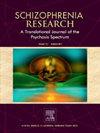癫后性精神病的TMS-EEG分析
IF 3.5
2区 医学
Q1 PSYCHIATRY
引用次数: 0
摘要
背景:后发精神病(PIP)是一种鲜为人知的并发症,影响了2%的癫痫患者。基因组学和神经影像学研究表明与精神分裂症有相似之处。目的探讨经颅磁刺激联合脑电图(TMS-EEG)是否能揭示精神分裂症样PIP的变化,特别是在固有频率(NF)、γ频带事件相关谱摄动(ERSP)、N100峰和全局平均场强(GMFP)方面。方法应用TMS-EEG对有PIP病史的局灶性癫痫(PWE)患者(n = 7)和无精神病史的PWE患者(n = 14)进行非优势半球运动前区定位。双尾t检验应用于先前在精神分裂症中研究的TMS-EEG指标,以寻找组间差异,亚组分析排除了使用苯二氮卓类药物的参与者。结果两组患者的人口学和临床特征相似。NF差异无统计学意义(p = 0.98)。在排除常规使用苯二氮卓类药物的患者后,我们观察到PIP组的N100峰潜伏期延迟(p = 0.05),并且在TEP的400-600 ms阶段全球平均电场功率增加(p = 0.02)。PIP组γ波段内的平均ERSP较低,但差异无统计学意义(p = 0.08)。结论本研究首次将TMS-EEG应用于PIP患者,证明了其可行性,并为今后的研究提供了方法学上的见解。初步发现,包括PIP中GMFP增加和N100潜伏期延迟,表明可能存在与精神分裂症相似的皮层兴奋性中断,值得进一步研究。本文章由计算机程序翻译,如有差异,请以英文原文为准。
TMS-EEG in postictal psychosis of epilepsy
Background
Postictal psychosis (PIP) is a poorly understood complication affecting 2 % of individuals with epilepsy. Genomic and neuroimaging studies suggest parallels with schizophrenia.
Objectives
To determine whether Transcranial Magnetic Stimulation coupled with Electroencephalography (TMS-EEG), can reveal schizophrenia-like changes in PIP, especially in Natural Frequency (NF), gamma band Event-Related Spectral Perturbation (ERSP), the N100 peak, and global mean field power (GMFP).
Methods
We applied TMS-EEG targeting the non-dominant hemisphere premotor area in people with focal epilepsy (PWE) with a history of PIP (n = 7) and PWE without any history of psychosis (n = 14). Two-tailed t-tests were applied to TMS-EEG metrics previously studied in schizophrenia to look for differences between the groups, with subgroup analyses excluding participants using benzodiazepines.
Results
Demographic and clinical characteristics were similar across the two groups. No significant differences were seen in NF (p = 0.98). We observed a delayed N100 peak latency in the PIP group when excluding those with regular benzodiazepine use (p = 0.05) and increased global mean field power during the 400-600 ms phase of the TEP (p = 0.02). Mean ERSP within the gamma band was lower in the PIP group, though this did not reach statistical significance (p = 0.08).
Conclusion
This is the first study to apply TMS-EEG in individuals with PIP, demonstrating feasibility and providing methodological insights for future studies. Preliminary findings, including increased GMFP and delayed N100 latency in PIP, suggest possible disruptions in cortical excitability similar to schizophrenia, warranting further investigation.
求助全文
通过发布文献求助,成功后即可免费获取论文全文。
去求助
来源期刊

Schizophrenia Research
医学-精神病学
CiteScore
7.50
自引率
8.90%
发文量
429
审稿时长
10.2 weeks
期刊介绍:
As official journal of the Schizophrenia International Research Society (SIRS) Schizophrenia Research is THE journal of choice for international researchers and clinicians to share their work with the global schizophrenia research community. More than 6000 institutes have online or print (or both) access to this journal - the largest specialist journal in the field, with the largest readership!
Schizophrenia Research''s time to first decision is as fast as 6 weeks and its publishing speed is as fast as 4 weeks until online publication (corrected proof/Article in Press) after acceptance and 14 weeks from acceptance until publication in a printed issue.
The journal publishes novel papers that really contribute to understanding the biology and treatment of schizophrenic disorders; Schizophrenia Research brings together biological, clinical and psychological research in order to stimulate the synthesis of findings from all disciplines involved in improving patient outcomes in schizophrenia.
 求助内容:
求助内容: 应助结果提醒方式:
应助结果提醒方式:


